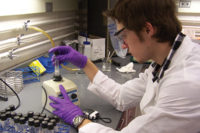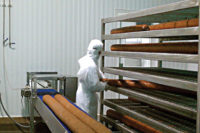When a person walks into a grocery store and picks up a package of sliced deli meat, there would be two things that person would do: First, he or she would look at the expiration date, then that person would look at the overall appearance of the meat inside.
Regardless of which action is performed first, the reason behind these actions is straightforward: The consumer is simply trying to visually assess both the safety and quality of the product. Once these criteria have received approval, the shopper might read on to the ingredients and nutritional panel in attempt to further analyze the quality of the product.
In order to actually convince the consumer to place the package of deli meat into their cart, all qualifications of the consumer must be met to their satisfaction.
Meeting the consumers’ safety and quality criteria is the challenge that manufacturers face every day, and the technology of high-pressure processing (HPP) is a promising solution.
HPP is engineered to apply extreme water pressure onto a packaged food product in order to inactivate microbial organisms while preserving the quality attributes and nutrients of the product. The process is similar to pasteurization in the ability to achieve microbial reduction, but unlike thermal pasteurization, HPP uses pressure to yield more desirable qualities of the food.
HPP offers an alternative to the use of chemical preservatives and will reduce the product degradation associated with post-thermal pasteurization. In fact, the growth of HPP in the food industry stemmed from an interest in Japan in 1980-1990 to find alternatives to the radiation processes.
The Japanese were so successful with the use of HPP technology, that it only took three years to release jams, jellies and sauce products treated by HPP. Later came the use of HPP for raw squid, and today on the American market there are companies using HPP for packaged raw beef. Expansion of HPP to the American market came when the engineering design went from vertical to horizontal systems, allowing for a more continuous batch system process. Having a continuous batch system process optimizes production efficiency and reduces costs per cycle. From 1996 to 2008, there has been approximately a 70% and 90% decrease in equipment and operating cost per cycle, respectively
As initial costs for HPP were high, it was difficult for food manufactures to accept it with open arms. This is not to say that they didn’t wantto welcome HPP, as its utility was very attractive and the research demonstrated it as a robust process ready for commercial acceptance.
It wasn’t until 2003, with the implementation of the FSIS rule designed to reduce Listeria monocytogenesin ready-to-eat (RTE) meat and poultry, that HPP was looked at again as a solution to the post-lethality treatment (PLT) processing step in RTE meat products. The use of HPP as a PLT for the control of Listeria would allow manufactures to eliminate the use of antimicrobials and keep that “clean” appeal to their product.
Furthermore, HPP would allow the RTE meat product to retain the nutrients and organoleptic (taste and texture) properties better than thermal pasteurization had been able to allow. Thus, with HPP, manufacturers could provide the consumer with the two attributes they look for in food, safety and quality.
As of September 2012, the FSIS compliance guidelines for the control of Listeriain RTE meats clearly identify HPP as an acceptable PLT. In May 2012, the USDA issued a directive on the validation for the use of HPP as a lethality treatment (LT) for the control of Listeria monocytogenesand Salmonellaspp in RTE meats, as well as for the control of E.coli O157 in both raw and RTE meat products.
As a result of both regulatory demand for safe foods and consumer demand for better tasting, preservative-free or low-sodium RTE meat products, the necessity for HPP has been growing. Whether you are starting from scratch at a new facility or would like to incorporate HPP into your existing facility, some important considerations need to be thought through.
As this is still a batch system, supplemental conveyors, loading stations and SCADA tracking systems allow better utilization of the equipment, which reduce costs and improve efficiency and product tracking. West Liberty Foods has installed three systems in its manufacturing facilities from HPP Hiperbaric, one of the largest HPP equipment suppliers in the world with several resources and extensive expertise to help integrate the HPP equipment into a production plan for optimal efficiency.
However, many meat and poultry processors do not have the means or demand for installing an entire system. In those cases, a more affordable option may be working with a toll processor to HPP your product.
Customers using a toll processor with HPP equipment can expect additional costs, but also a great deal of expertise both from the toll processor and even the equipment vendors. A toll processor can be the solution for a meat manufacturer who wants to include HPP as an added step to provide a PLT or LT for Listeria, E.coliO157 and Salmonella spp., while retaining the quality of the product.
It should be noted that this additional step is not an invitation to let slack the safety and quality systems up front — all programs related to HACCP and food safety need to be in place. However, HPP certainly adds a robust improvement to the food-safety systems.
As consumers demand higher-quality products, are they the ones now putting “pressure” on meat manufactures to look at using HPP as a step in their process? Only 20 years after the commercialization of HPP, is it possible that HPP could surpass pasteurization as the leading choice for a PLT in RTE meat products?
My answer to both of these questions is, “Yes, the possibility is there, the need is now, and the ‘pressure’ is on.”








Report Abusive Comment